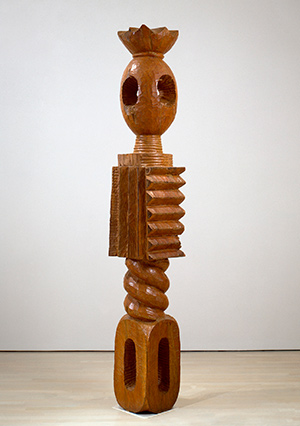
King of Kings
Constantin Brancusi
King of Kings (Le roi des rois), 1938
Oak
300x 48.3x 46 cm
Solomon R. Guggenheim Museum, New York
© VEGAP, Bilbao, 2016
Photo: David Heald © SRGF
“When we are no longer children, we are already dead.” Constantin Brancusi[1]
Constantin Brancusi (b. Hobita, Romania, 1876; d. Paris, 1957) broke from many of the conventions of sculpture. He worked for the French master sculptor Auguste Rodin (1840-1917) for only a month in 1907 before leaving. He argued, "Nothing can grow in the shadow of a great tree." While Rodin used many assistants to help him cast or carve his sculptures, Brancusi preferred to create his with his own hands, making an intimate connection with the materials, most often through direct carving.
During and immediately after World War II, Constantin Brancusi began to focus almost exclusively on sculpting with wood, a material that he considered full of metaphoric potential and with which he was intimately familiar from having trained as a carpenter. By 1924, he was portraying himself in photographs as a Romanian peasant woodcutter working amidst his sculptures[2] (as opposed to Auguste Rodin, who was often portrayed like The Thinker, aloof from his works).
The monumental oak King of Kings (Le roi des rois, 1938) was originally intended to stand in Brancusi’s Temple of Meditation, a private sanctuary commissioned in 1933 by the Maharaja Yeshwant Rao Holkar of Indore. Although never realized, the temple—conceived as a windowless chamber (save for a ceiling aperture) with interior reflecting pool, frescoes of birds, and an underground entrance—would have embodied the concerns most essential to Brancusi’s art: the idealization of aesthetic form; the integration of architecture, sculpture, and furniture; and the poetic evocation of spiritual thought. Brancusi’s forms in King of Kings were inspired by African sculptures and carvings, Romanian woodwork, and the contemporary avant-garde’s path to abstraction. These forms imbued his sculptures with additional metaphorical readings or at least associations, and he often combined them with each other, playing with them like toys in his studio and photographing them in various configurations. Many of Brancusi’s sculptures remained in his studio for long periods of time-if only because he couldn’t always sell them. While there, he not only rearranged them but carved and recarved, destroyed and rebuilt them constantly.[3]
Wood elicited from Brancusi a tendency toward Expressionism, resulting in unique carved objects. While his sculptures executed in stone or metal represent archetypal forms, such as birds in flight and sleeping figures, individual works in wood suggest specific characters or spiritual entities. For example, King of Kings may be interpreted as Brancusi’s attempt to translate the power of Eastern religion into sculptural form. The work’s original title was Spirit of Buddha (L’esprit du Bouddha), and Brancusi is known to have been familiar with Buddhism through the writings of the Tibetan philosopher Milarepa.
Preguntas
Look together at King of Kings, 1938. Ask students to sketch the image. Then ask them to discuss in pairs what they noticed while they sketched.
Ask students what they might title this work. Create a list of possible titles. Now, give students the title of the work and ask them how they think it relates to the sculpture
